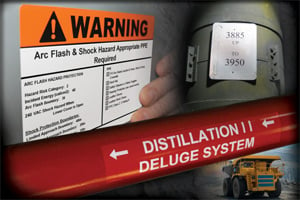
8 Tips on Designing Attention-Getting Workplace Safety Signs
 When it comes to warnings about potential dangers or giving people an important instruction on site, you have to rely on labels and signs to communicate. A sign's message can be communicated effectively with a picture that can be understood across all ages and languages (see Why Using Visuals in your Communication is so Important for more information on why visuals work so well).
When it comes to warnings about potential dangers or giving people an important instruction on site, you have to rely on labels and signs to communicate. A sign's message can be communicated effectively with a picture that can be understood across all ages and languages (see Why Using Visuals in your Communication is so Important for more information on why visuals work so well).
Multinationals employing thousands of workers from Boston to Bangkok and even small companies employing just a few, can benefit from a few key guidelines when creating signs, ensuring that messaging and communications are effective.
8 Tips for Creating Effective Signs
They are:
- Make them application-appropriate. While 9" tall bar code labels are helpful in warehouses, they don’t make sense when labeling test tubes. In either case, print labels at high quality (300 dpi) for readability, and use pictograms to illustrate your message. If conditions are unusual (such as labels that will be subjected to high or low temperatures), select a supply designed to withstand such an environment.
- Choose your font wisely. Graphic designer Sonia Mansfield says, “The best font choices are ones where readers do not notice the font, only the message. Overly elaborate fonts detract from your message. Fonts that are too blocky can also be unreadable.”
- Wording should be easy to read and concise yet contain sufficient information to be quickly understood. Include contact information when relevant, such as emergency phone numbers for fire department, police department and ambulance.
- Make sure the sign is clean and in good condition. They should be free of sharp edges, burrs, splinters or other sharp projections and should be attached securely so that the sign itself is not a hazard.
- Limit your signs. A jumble of signs means that people cannot read and absorb all messages while passing by, and the messages will be lost. Avoid placing too many signs within a small area.
- Choose colors that will be visible in their intended surroundings. Color-coded wire and cable markings indicate different uses such as grounding, hot wiring and utility locations. Phosphorescent signs enjoy maximum visibility in no-light conditions.
- Learn from experience. Often you don't know where to place signs, until poor safety behaviour occurs. Exuberant baseball fans were risking their lives by leaning over stadium railings to catch foul balls. Alert stadium facility managers raised the railings to prevent accidents and placed prominent, heavy-duty safety labels on the railings.
- Make sure your signs and labels are made to last. Specially engineered supplies provide lasting performance on surfaces like oily drums, near electrical circuits or even on freezing pipes.
When checking your site for the relevance of current signs, ask yourself these questions:
- Is the sign appropriate for the hazard?
- Is it placed in the proper location to inform people of potential danger?
- Has the facility changed layout or equipment placement? If so, was the effectiveness of safety signs evaluated at that time?
- Has the workforce changed to now include people who speak a different language?
- Is the sign easy to understand?
- Is the sign in good condition and still readable?
If you answered, no to any of these questions. Then, it's time to replace your safety signs and labels.
Whether you’re a safety manager from Sydney or a facility manager from Forbes, consistent use of safety signs play a critically important role in reducing injuries and saving lives at industrial facilities.
Guest Blogger: Jack Rubinger, www.DuraLabel.com, has more than 20 years of safety and visual communications writing experience. For more information about this article, call 800-788-5572 or email jarubinger@graphicproducts.com.

